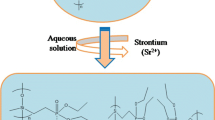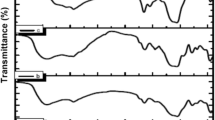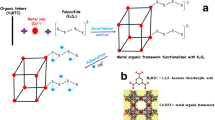Abstract
Insoluble porous solid functionalized ligand system bearing 2-aminophenylaminopropyl chelating ligand of the general formula P–(CH2)3NH–(C6H4)–NH2 was prepared via the sol–gel process, where P represents [Si–O] n polysiloxane network. First, the 2-aminophenylaminopropylsilane agent was prepared by substitution reaction between 3-chloropropyltrimethoxysilane and 1,2-phenylenediamine, followed by hydrolytic polycondensation between 2-aminophenylaminopropylsilane agent and tetraethylorthosilicate(TEOS). The immobilized 2-aminophenylaminopropylpolysiloxane P–(CH2)3NH–(C6H4)–NH2(P–AphA) was characterized by 13C NMR, XPS, and FTIR. The results showed that 1,2-phenylenediamine groups were introduced onto polysiloxane network. The functionalized ligand system exhibits 90–100% metal uptake capacity for all metal ions except Cd2+. The elemental analysis data and the metal uptake capacities of the immobilized ligand system suggest that over than 90% ligand sites were involved in coordination with metal ions except that of cadmium forming 1:1 metal to ligand ratio complexes.







Similar content being viewed by others
References
Ahmed I, Parish RV (1993) Insoluble ligands and their applications: IV polysiloxane-bis(2-aminoethyl) amine ligands and some derivatives. J Organomet Chem 452:23. doi:10.1016/0022-328X(93)83167-T
Allum KG, Hancock RD, Howell IV, Mckenzie S, Pitkethly RC, Robinson PJ (1975) Supported transition metal complexes, silica as the support. J Organomet Chem 87:203. doi:10.1016/S0022-328X(00)91286-5
Bailey DC, Langer SH (1981) Immobilized transition-metal carbonyls and related catalysts. Chem Rev 81:109. doi:10.1021/cr00042a001
Beamson G, Briggs D (eds) High resolution XPS of organic polymer, The Scienta ESCA300 Database, John Wiley, Chichester (1992)
El-Ashgar NM, El-Nahhal Issa M (2005) Preconcentration and separation of copper(II) by 2-aminopropylpolysiloxane-immobilized ligand system. J Sol Gel Sci Tech 34(2):165. doi:10.1007/s10971-005-1354-9
El-Nahhal IM, Zaggout FR, El-Ashgar NM (2000a) Uptake of divalent metal ions(Cu2+, Zn2+, and Cd2+) by polysiloxane-immobilized monoamine ligand system. Anal Letters 33:2031. doi:10.1080/00032710008543173
El-Nahhal IM, Chehimi MM, Cordier C, Dodine G (2000b) XPS, NMR and FTIR structural characterization of polysiloxane-immobilized amine ligand systems. J Non-Cryst solids 275:142. doi:10.1016/S0022-3093(00)00243-X
El-Nahhal IM, Zaggout FR, El-Ashgar NM (2001) Uptake of divalent metal ions(Cu2+, Ni2+, Co2+) by polysiloxane-immobilized triamine-thiol and thiol-acetate ligand systems. Anal Lett 34:247. doi:10.1081/AL-100106850
El-Nahhal IM, El-Shetary BA, Salib KAR, El-Ashgar NM, El-Hashash AM (2002) Polysiloxane-immobilized triamine ligand system, synthesis and applications. Phosphorus Sulfur Silicon Relat Elem 177:741. doi:10.1080/10426500210274
El-Nasser AA, Parish RV (1999) Solid polysiloxane ligands containing glycine or iminodiacetate groups, synthesis and applications. J Chem Soc Dalton Trans 19:3463. doi:10.1039/a903258d
Khatib IS, Parish RV (1989) Insoluble ligands and their applications: I A comparison of silica-immobilized ligands and functionalized polysiloxanes. J Organomet Chem 369:9. doi:10.1016/0022-328X(81)80002-2
Leyden DE (1980) In: DE Leyden DE, Collins (WT) (eds) Silylated surface. Gordon and breach science, New York, p 333
López T, Herrerra L, Mendez J, Bossh P, Gómes R, Gozález R (1992) Supported effect in ruthenium sol–gel catalysts on silica and alumina. J Noncryst Solids 147:773. doi:10.1016/S0022-3093(05)80715-X
Moulder JF, Stickle WF, Sobol PE, Bomben KD, Chastain J (1992) Handbook of X-ray photoelectron spectroscopy, 2nd edn. Perkin-Elmer Corporation, Eden Prairie, p 182
Murell LL (1977) In: Burton JJ, Garen RL (eds) Advanced material in catalysis. Academic Press, New York, p 236
Parish RV, Habibi D, Mohammadi V (1989) Insoluble ligands and their applications: II polysiloxane-phosphine ligands, their complexes and hydrogenation catalysts. J Organomet Chem 369:17. doi:10.1016/0022-328X(81)80003-4
Trofimchuk AK, Kuzovenko VA, Melnik IV, Zub YL (2006) Comparison of the complexation abilities of bifunctional polysiloxane xerogels and chemically modified silica gels. Russian J Appl Chem 79:229. doi:10.1134/S1070427206020121
Yang JJ, El-Nahhal IM, Maciel GE (1996) Synthesis and solid state NMR structural characterization of some functionalized polysiloxanes. J Noncryst Solids 204:105. doi:10.1016/S0022-3093(96)00412-7
Yang JJ, El-Nahhal IM, Chung IS, Maciel GE (1997) Synthesis and solid state NMR structural characterization of polysiloxane-immobilized amine ligands and their metal complexes. J Noncryst Solids 209:19. doi:10.1016/S0022-3093(96)00534-0
Author information
Authors and Affiliations
Corresponding author
Rights and permissions
About this article
Cite this article
El-Ashgar, N.M., El-Nahhal, I.M., Chehimi, M.M. et al. Extraction of Co, Ni, Cu, Zn and Cd ions using 2-aminophenylaminopropylpolysiloxane. Environ Chem Lett 8, 311–316 (2010). https://doi.org/10.1007/s10311-009-0223-0
Received:
Accepted:
Published:
Issue Date:
DOI: https://doi.org/10.1007/s10311-009-0223-0




